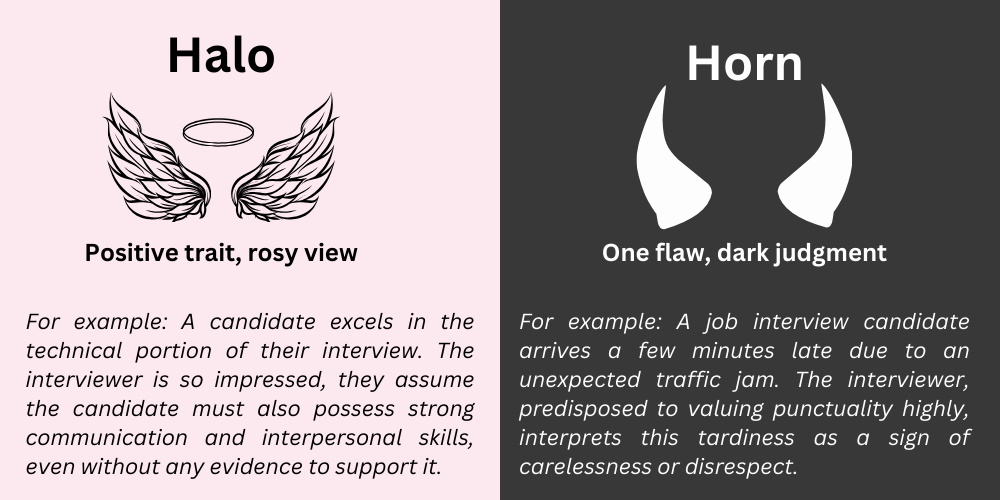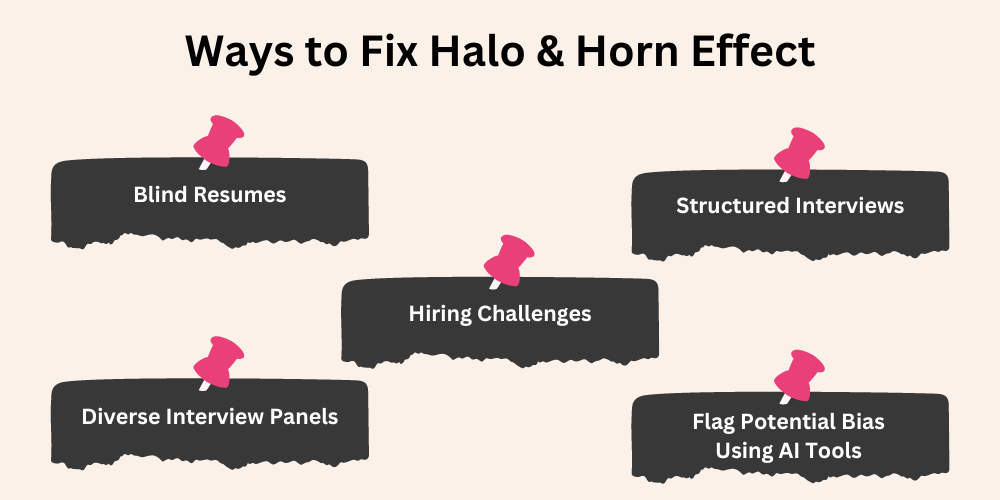- Defining Halo and Horn Effects
- Impact of Halo and Horn Effect on Hiring Decisions
- Strategies to Combat Halo and Horn Effect In Hiring
- Final Thoughts
- Frequently Asked Questions
Beyond First Impressions - Deflecting The Halo And Horn Effect In Hiring

In the world of hiring, first impressions can often make or break a candidate's chances of landing a job. But what if we told you that these initial judgments could be influenced by the inherent biases of the hiring manager? Even seasoned hiring professionals can possess these biases, impacting the fairness of the recruitment process.
One of the biases that hiring managers may come under the influence of is the Halo and Horn effect. This concept sheds light on how our brains tend to generalize a person's overall character based on just one positive or negative attribute, ultimately shaping our decision-making process in ways we may not even realize. Let's dig deeper to understand this bias and explore how it impacts the hiring process in ways we never imagined.
What is Halo and Horn Effect?

The Halo and Horn effect stems from our tendency to make snap judgments about others based on a single positive or negative trait. These are two closely related biases that distort our perception of others based on a single positive or negative trait. In other words, the Halo and Horn effect are like coloured glasses we wear when judging people.
The Halo effect makes us see someone with one positive quality as amazing in all aspects, even if there's no evidence. The Horn effect works the other way. One negative impression can lead us to unfairly judge a person as bad at everything. In both cases, our overall impression is biased by a single trait, leading to inaccurate evaluations.
In hiring, the Halo effect occurs when an interviewer's positive impression of a candidate influences their assessment of the candidate's skills beyond what is objectively warranted.
For example, a candidate with an impressive educational background from a prestigious university may be seen as highly competent and capable, even if their relevant experience or skills are lacking.
On the contrary, the Horn effect happens when a negative trait or experience clouds the overall judgment of a candidate.
For instance, a candidate with a minor gap in their employment history may be unfairly judged as unreliable or uncommitted despite their strong track record of performance in previous roles.
Impact of Halo and Horn Effect on Hiring Decisions
The Halo and Horn effect can significantly impact hiring decisions in several ways:
- Interview Evaluation: During interviews, interviewers may subconsciously focus on the positive or negative aspects of a candidate's profile, leading to an imbalanced assessment of their overall fit for the role.
- Resume Screening: Recruiters may prioritize candidates with prestigious backgrounds or credentials (Halo effect) while overlooking qualified candidates with less impressive resumes (Horn effect).
- Reference Checking: References provided by candidates may be biased towards highlighting either the candidate's strengths (Halo effect) or weaknesses (Horn effect), influencing the hiring manager's perception of the candidate.
- Decision-Making: Halo and Horn effect can impact final hiring decisions, leading to missing out on talented individuals or selecting candidates who may not be the best for the company.
- Team Dynamics: Hiring decisions influenced by the Horn effect can result in a less diverse and inclusive team, as qualified candidates are overlooked due to biased evaluations.
- Employee Retention: Candidates selected based on the Halo effect may struggle to meet expectations, leading to lower job satisfaction and higher turnover rates within the company.
- Organizational Culture: The cumulative impact of hiring decisions affected by the Halo and Horn effect can shape the overall culture of the company, impacting employee morale and productivity.
In short, being aware of and actively working to mitigate the Halo and Horn effect and other biases in hiring decisions is crucial for building a strong and diverse workforce that can drive organizational success.
Strategies to Combat Halo and Horn Effect During Hiring

Building a hiring process that minimizes the Halo and Horn effect requires a multi-pronged approach. Here are some practical and creative strategies to consider:
Pre-Recruitment
- Standardized Job Descriptions: Develop clear and concise job descriptions that focus on the essential skills and experience needed for the role. Avoid using subjective language that might trigger bias based on perceived personality traits.
- Diverse Recruitment Channels: Advertise your open positions across a variety of platforms to attract a wider pool of candidates from different backgrounds. Partner with organizations that champion diversity and inclusion.
During the Application Process
- Blind Resumes: Consider removing identifying information like names and universities during the initial screening stage. This forces recruiters to focus solely on qualifications and relevant experience.
- Structured Interviews: Develop a standardized interview format with a set of predetermined questions that are relevant to the job requirements. Ask all candidates the same questions in the same order to ensure a fair and consistent evaluation.
- Behavioural Interviewing: Focus on using the STAR method (Situation, Task, Action, Result) to ask candidates about past experiences related to the required skills. This reveals tangible examples of how they tackled challenges and achieved results.
Interview Techniques
- Diverse Interview Panels: Assemble interview panels with a mix of genders, ethnicities, and backgrounds. This creates a broader perspective and reduces the impact of individual biases.
- Mindfulness Training: Train interviewers to be aware of the Halo and Horn effect and its influence on their decision-making. Encourage them to actively challenge assumptions made during the interview and focus on objective criteria.
- Calibrated Interview Scoring: Implement a scoring system that outlines specific criteria against which candidates are evaluated. This helps ensure fairness and consistency across different interviewers.
Creative Solutions
- Skills Assessments: Utilize standardized skills assessments to objectively evaluate job-related competencies. These can range from writing tests to practical simulations, offering a more unbiased measure of candidate capabilities.
- Hackathons or Challenge-Based Interviews: These methods can bypass traditional resumes and first impressions, focusing on skills and problem-solving abilities in a more engaging environment. Observe how candidates approach challenges and collaborate within a team setting.
- Anonymous Feedback Surveys: After the interview process, anonymously gather feedback from candidates about their experience. This can reveal areas where the process might unwittingly favor or disfavor certain types of candidates.
Post-Interview
-
Debriefing with Interview Panels: After each interview, have the panel discuss the candidate's performance objectively, focusing on specific skills and how they align with predetermined criteria. Avoid subjective assessments based on personality traits or first impressions.
Take the bias-free hiring approach. Evaluate candidates through a wide range of assessments, case studies, simulations and more on Unstop. Let's show you around!
Technology Solutions
- Diversity Recruiting Software: These tools can assist in sourcing diverse candidates and screening resumes in a way that removes identifying information. They can also help analyze job descriptions for potential bias and suggest more inclusive language.
- AI-powered Interview Platforms: Some platforms utilize artificial intelligence to analyze interview responses for signs of bias and ensure consistency in questioning. It's important to use such tools with caution and prioritize human judgment in the final hiring decisions. AI can be a valuable tool to flag potential bias, but human judgment is still crucial for assessing a candidate's fit for the role and company culture.
Building a Culture of Fairness
- Leadership Commitment: Senior leadership needs to actively champion diversity and inclusion initiatives and ensure accountability throughout the hiring process. This sends a strong message about the importance of fair hiring practices.
- Employee Resource Groups (ERGs): Providing platforms for employees from diverse backgrounds to connect and advocate for fair hiring practices fosters a more inclusive environment. ERGs can offer valuable insights and perspectives on how to improve the hiring process.
- Regular Reviews and Monitoring: Continuously monitor your hiring process for potential bias. Analyze data on candidate demographics and identify areas for improvement. Regularly review and update your job descriptions, interview questions, and scoring criteria.
Final Thoughts
Avoiding the Halo and Horn effect in hiring is an ongoing process that requires continuous effort and vigilance. By implementing the strategies and techniques outlined above, you can create a more objective and fair hiring process that attracts and selects the best talent, regardless of background or first impressions.
In closing, here are some additional tips to keep in mind:
- Focus on the role, not the person: Throughout the hiring process, keep your focus firmly on the requirements of the job and the specific skills and experience needed to succeed. Don't get sidetracked by personality traits or irrelevant factors.
- Celebrate diverse perspectives: Recognize that different backgrounds and experiences can be valuable assets. Hiring a team with a variety of perspectives can lead to better decision-making and a more innovative work environment.
- Be transparent and consistent: Communicate your commitment to fair hiring practices to all candidates. Ensure consistency in the interview process and application of selection criteria.
By taking these steps, you can build a stronger hiring process that minimizes bias and helps you find the best talent to propel your organization forward.
Frequently Asked Questions
Q1. What are the Halo and Horn effects in hiring?
The Halo effect is when a positive impression of a candidate influences overall judgment, while the Horn effect is the opposite, where a negative trait overshadows other qualities. Both biases can impact hiring decisions.
Q2. How do Halo and Horn effects impact hiring decisions?
These effects can lead to biased judgments during interviews or resume reviews. The Halo effect may cause overlooking weaknesses, while the Horn effect can unfairly emphasize a single flaw, affecting fair evaluation of candidates.
Q3. What is the difference between the Halo and Horn Effects in hiring?
The key distinction lies in their outcomes: Halo effect leads to favourable bias based on one positive trait, while the Horn effect results in unfavourable bias due to one negative aspect. Understanding these biases is crucial for fair recruitment processes.
Q4. How can companies avoid bias related to the Halo and Horn effects in hiring?
To mitigate these biases, companies should implement structured interview processes, use standardized evaluation criteria, provide training on unconscious bias awareness, and involve diverse interview panels to ensure fair assessment of candidates.
Why is it important to address biases like the Halo and Horn effects in hiring?
Biases like the Halo and Horn effects can lead to unfair hiring decisions based on superficial qualities rather than qualifications. Addressing these biases ensures a more objective evaluation of candidates, leading to a diverse and talented workforce. By recognizing and mitigating these biases, companies can improve their overall hiring process and create a more inclusive work environment.
Suggested Reads:
As a biotechnologist-turned-writer, I love turning complex ideas into meaningful stories that inform and inspire. Outside of writing, I enjoy cooking, reading, and travelling, each giving me fresh perspectives and inspiration for my work.
Login to continue reading
And access exclusive content, personalized recommendations, and career-boosting opportunities.
Subscribe
to our newsletter
Blogs you need to hog!

Organize Hackathons: The Ultimate Playbook With Past Case Studies

What is Campus Recruitment? How To Tap The Untapped Talent?

Lateral Hiring: A Complete Guide To The Process, Its Benefits, Challenges & Best Practices













Comments
Add comment